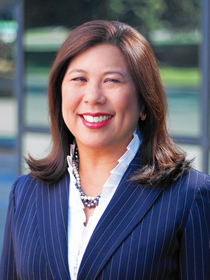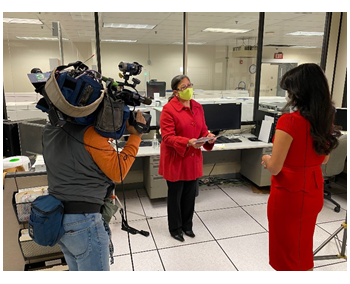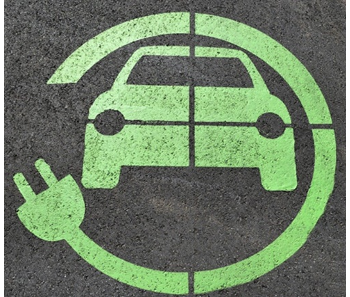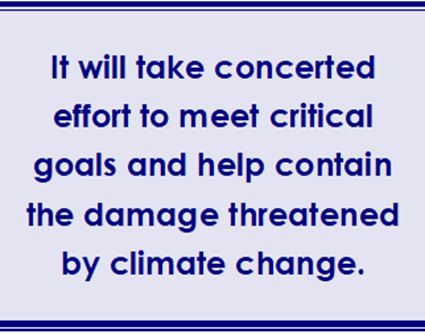You can also view this newsletter as a PDF.

Tireless SCO Team Members Committed to
Getting Stimulus Funds to Californians in Need
An Open Letter from Controller Yee
Even in a typical year, it takes an experienced, full-time team of public service professionals to help California – the world’s fifth-largest economy – issue more than 49 million payments to state employees, vendors, local governments, school districts, and taxpayers. I think most would agree that the last year and a half has been anything but “typical.”
Businesses large and small have had to adapt on the fly to the changing realities of the workforce, in the interest of public health. This has been no less true for the State Controller’s Office (SCO). While many people serve in roles that allow working from home, the disbursements professionals who represent the very best in state service and too often go unnoticed have been on the front lines, in-person, daily, even as their workload has grown tremendously. I want to express my deep gratitude for the role they have played in moving our economy forward.
This February, Governor Gavin Newsom signed into law the Golden State Stimulus (GSS) program to provide lower-income Californians with financial support to help them weather economic impacts of the COVID-19 pandemic. In July, he approved a second round of GSS. With more than half of Californians qualifying for at least one of these stimulus payments, chances are you know someone positively affected by the support.

GSS increased SCO’s annual payment volume by 24 percent. Since March, SCO has issued 10 million GSS payments totaling $6.8 billion, with an additional 1.9 million payments expected by the end of the month. The increase did not come without challenges, but employees went the extra mile to address them and make these critical payments.
Staff responsible for printing and mailing payments expanded operations from 16 hours a day to 20 hours a day to ensure GSS payments were produced on time with no interruption to other vital payments issued by SCO. Employees worked evenings, weekends, and overtime in a well-choreographed effort involving printing, folding, inserting, sorting, and mailing. Beyond the record increase in paper warrant payments, GSS led to other firsts for SCO. Before the second round of GSS, the highest number of direct deposit payment (EFT) requests received at one time was approximately 300,000. The initial EFT payment file for GSS II contained almost two million EFT payments, an 85 percent increase.
Between the issuance of the first and second rounds of GSS payments, SCO also began implementation of a modernization and process-improvement plan years in the making that affects both print and mail operations. SCO team members have successfully kept the modernization on track without missing a beat in producing a greatly increased number of payments.
From planning through issuance of the first round of GSS payments, SCO worked closely with Franchise Tax Board (FTB) to develop solutions for issuing timely, accurate payments; and meeting all audit requirements to safeguard taxpayer dollars from fraud or erroneous payments. After the first round of GSS payments, SCO and FTB discussed successes and looked for ways to improve any future payment programs – a proactive move which proved instrumental to the second round of GSS. In the midst of a worldwide paper shortage, SCO undertook fast-paced and specialized solicitations to ensure unique warrant stock was on hand and tested, and programming updated, allowing banks to easily identify and track GSS payments deposited by their members.
California’s efforts to help those most hard-hit by the pandemic was critical to regaining the economic footing on which the state now rests, and the tireless efforts of countless state employees to implement those efforts should not go overlooked.
Many of those involved in this exhaustive effort have expressed to me how rewarding it is to see how their work has touched the lives of so many Californians. They take great pride in providing excellent customer service, and they are inspired by and grateful for the kind words that have poured back in from those who have received GSS payments.
I want to take this opportunity to publicly thank and congratulate the dedicated SCO team members who have worked throughout a pandemic to ensure California continues to meet all payment obligations, particularly the stimulus payments that have been critical to uplifting those hardest hit by the economic burdens of COVID-19.
COP26 Promises Continued Progress
Toward Critical Climate Goals
Government leaders, investors, scientists, and stakeholders held high hopes entering the United Nations (UN) Climate Change Conference (COP26) held October 31 through November 12 in Glasgow, Scotland. Although reductions in global greenhouse gas (GHG) emissions remain far from the 2015 Paris Agreement levels needed to limit the impacts of climate change, this year’s gathering did result in concrete actions to further progress.
The U.S. delegation made a strong showing, highlighting actions taken by the Biden Administration to restore the nation’s commitment to combatting climate change, after the prior administration announced its intention to pull out of the Paris Agreement. The U.S. and other countries reaffirmed a commitment to limiting the increase in the global average temperature to well below 2° Celsius, with the ultimate goal of limiting the increase to 1.5° Celsius.
Signatories recognized carbon emissions must be reduced by 45 percent over the next nine years to reach net zero by 2050. To help meet that goal, stronger national action plans are expected to be submitted to the UN in 2022, well ahead of the original 2025 deadline.
After much discussion and multiple drafts, leaders agreed to phase down coal power and phase out “inefficient” fossil fuel subsidies. Many delegations were disappointed the language on coal was significantly weakened from phase out to phase down, but it is noteworthy that fossil fuels were specifically called out for the first time in these talks.
Financial support for climate solutions and adaptations in developing countries lags behind the $100 billion annual commitment pledged by developed nations in 2015. These developed countries recommitted to the pledge and expect to provide full financial support by 2023.
Leaders also reached agreement on operational details to implement the Paris Agreement. These include norms related to carbon markets to help countries meet their emissions targets, and the establishment of timelines and formats for countries’ required progress reports.
 In addition to the formal agreements, there were several significant announcements made during the two-week conference:
In addition to the formal agreements, there were several significant announcements made during the two-week conference:
Forests—137 countries pledged to halt and reverse forest loss and land degradation by 2030. The commitment is backed by $12 billion in public funding and $7.2 billion in private funding. In addition, CEOs of dozens of financial institutions with more than $8.7 trillion in global assets under management (AUM) committed to eliminating investment in activities linked to deforestation.
Methane—103 countries, including 15 major emitters, signed onto the Global Methane Pledge, which aims to reduce methane emissions by 30 percent by 2030 compared to 2020 levels. Scientists believe methane is responsible for a third of current warming from human activities.
Vehicles—30 countries, six major vehicle manufacturers, and other actors – like cities and states – reached a more rigorous agreement to restrict the sale of new cars and vans to electric only in leading markets by 2035, and by 2040 globally, accelerating adoption of zero-emission vehicles. Vehicle emissions currently account for 10 percent of global GHG emissions.
Coal—The U.S., United Kingdom, and European Union announced a partnership to provide South Africa – the world’s most carbon-intensive electricity producer – with $8.5 billion over the next five years for a just transition away from coal.
Private Finance—Central banks and financial institutions announced plans to realign trillions of dollars to achieve global net-zero emissions.
As a board member of the California Public Employees’ Retirement System (CalPERS) and California State Teachers’ Retirement System (CalSTRS), Controller Yee is proud of the work both public pension funds are doing to ensure investment portfolios move toward net zero. She sees a clear link between climate impacts and the long-term sustainability of fund returns. A 2019 survey of 215 of the world’s 500 largest companies by global nonprofit CDP found nearly $1 trillion in reported climate-related financial risk. The Sustainability Accounting Standards Board’s research shows investors consider the nature of the risk faced by companies to be so significant that they identified climate change as being material for 72 out of 79 industry sectors.
 In September, the CalSTRS board committed to a net-zero investment portfolio no later than 2050. This move was spurred by internal analysis of financial and physical impacts of climate change on the portfolio over the last two years. Staff members are working on a CalSTRS Net Zero Action plan based on clear initial governance, appropriate methodologies and frameworks, and portfolio emissions measurement. The plan will include interim milestones for managing emissions-related risks, and a pledge to publish regular reports of net-zero investments.
In September, the CalSTRS board committed to a net-zero investment portfolio no later than 2050. This move was spurred by internal analysis of financial and physical impacts of climate change on the portfolio over the last two years. Staff members are working on a CalSTRS Net Zero Action plan based on clear initial governance, appropriate methodologies and frameworks, and portfolio emissions measurement. The plan will include interim milestones for managing emissions-related risks, and a pledge to publish regular reports of net-zero investments.
This plan builds on the work CalSTRS has done, including investments in low-carbon transition funds. CalSTRS is focused on private market investments in affordable housing, zero-carbon energy solutions, resource efficiency, and agriculture management. Corporate engagement is another priority, as evidenced by CalSTRS’ efforts to support a successful election of three new directors to the ExxonMobil board, which is expected to help the company transition. CalSTRS is part of Climate Action 100+, targeting electric utilities, oil and gas refiners, and other manufacturers. The fund also has had a long-standing engagement on methane.
CalSTRS traditionally has managed a broad public equity investment portfolio with a strong governance process; environmental, social, and governance-focused (ESG) investments; and a low-carbon index. These investments have a current value of approximately $8 billion. The board recently approved a private market portfolio managed by the Sustainable Investment and Stewardship Strategies (SISS) team to expand the fund’s already significant number of investments in low-carbon solutions. This new portfolio, when combined with existing SISS investments, has a target of 5 percent of the total fund (currently approximately $15.6 billion). Initially, staff will focus on investing in low-carbon solutions related to energy, technology-enabled resource efficiency, water and waste management, and land and agriculture management.
CalPERS also has committed to a net-zero portfolio by no later than 2050. Instead of shedding carbon-intensive investments from the portfolio, CalPERS continues to focus on engagement with public corporations to lower corporate emissions. CalPERS is a co-founder of Climate Action 100+, which now includes 615 investors with $60 trillion AUM engaging with 167 companies. As of August 2021, 111 target companies have set net-zero or equivalent targets, which by 2050 is estimated to reduce GHG emissions by 9.8 billion metric tons, equivalent to more than a quarter of today’s global GHG emissions.
Advocacy with regulators and legislators is another key component of CalPERS’ sustainability strategy. The fund has provided comments to the U.S. Securities and Exchange Commission on climate risk reporting standards and is leading efforts to expand the Climate Action 100+ benchmark to include indicators on just transition, climate accounting, and ensuring corporations do not support lobbying efforts counter to stated climate goals. This will help assess 1.5° Celsius scenarios of companies, and allow investors to better assess their own portfolios. Controller Yee believes establishing a meaningful price on carbon also is necessary to help shift consumer behavior, companies’ actions, and the economy as a whole to a low-carbon framework.
 CalPERS’ portfolio currently has more than $20 billion invested in low-carbon solutions and green investments. This includes $12.1 billion – or approximately 18 percent – of all private asset investments in climate solutions, renewable energy, and sustainably certified buildings. CalPERS recently cofounded the ESG Data Convergence Project, which will standardize reporting on ESG performance of private equity portfolio companies. These metrics also include Scope 1 and 2 GHG emissions. The fund also has invested more than $7.5 billion in low-carbon transition solutions in public equities and green bonds.
CalPERS’ portfolio currently has more than $20 billion invested in low-carbon solutions and green investments. This includes $12.1 billion – or approximately 18 percent – of all private asset investments in climate solutions, renewable energy, and sustainably certified buildings. CalPERS recently cofounded the ESG Data Convergence Project, which will standardize reporting on ESG performance of private equity portfolio companies. These metrics also include Scope 1 and 2 GHG emissions. The fund also has invested more than $7.5 billion in low-carbon transition solutions in public equities and green bonds.
Controller Yee firmly believes it will take the concerted efforts of government, corporations, investors, and citizens to meet the critical goals laid out in the Paris Agreement and help to contain the damage threatened by climate change. She is committed to ensuring, in her role as a fiduciary, that actions taken today will help achieve the necessary carbon reductions to thwart negative climate impacts.